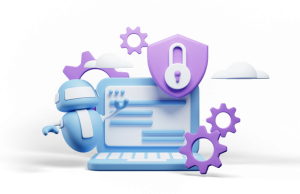Did you know that the average cost of a data breach is $4.35 million per incident? IBM reports that remote work negatively impacts this figure, while healthcare-related breaches have seen a significant spike in costs. Compromised credentials continue to be one of the most frequent causes of breaches. However, modern cybersecurity techniques can significantly lower the overall cost of such incidents. It is essential to implement proper cybersecurity measures to safeguard users, devices, and information in today’s IT landscape. One popular solution to consider is modern single sign-on (SSO) technology, which can improve cybersecurity and compliance simultaneously.
The modern era of automation and streamlining of processes has led to significant improvements in workplace productivity. However, it has also increased the risk to organizations. Each new tool or app added to our technology toolkit, every password entered, and every network connected only adds to our attack surface, providing malicious actors with countless avenues to cause harm if not properly safeguarded.
In this article, you will read about:
What is SSO?
Benefits and potential pitfalls of Single Sign-On (SSO)
Identifying and Mitigating Weak Links in the Authentication Chain
Why SSO is critical for Compliance?
Rainbow Secure SSO
How can Rainbow Secure help?
Organizations today have a broad range of tools and resources at their disposal. However, accessing these resources requires multiple sets of credentials, which can pose security risks. Adopting a secure single sign-on solution can greatly improve the situation. By using one reinforced set of credentials, organizations can benefit in several ways. One of the biggest benefits is that it reduces the number of attack vectors, and when combined with multi-factor authentication (MFA), it creates a robust security and compliance framework.
What is SSO?
Single sign-on (SSO) is an authentication approach that enables users to log in once, at the start of their work shift, using a single set of credentials – usually an ID and password. This grants users access to multiple applications and websites without having to waste time logging in repeatedly. It’s similar to a “master sign-on.” The SSO service creates an authentication token every time a user logs in. This token remembers that the user has been verified. When the user visits any application or website later in their work shift, the SSO service sends the user’s token to confirm their identity and grant access. This means that when a user logs into another application or software after their first “master sign-on,” the SSO solution logs in on their behalf.
- Implementing a comprehensive single sign-on (SSO) solution within your IT system can significantly reduce your organization’s attack surface in several ways, including:
- Reducing the number of credentials that end users require to access their resources, which limits the potential for phishing attacks
- Reducing the chances of cybercriminals using stolen credentials from a previous breach against your organization
- Adding multi-factor authentication to SSO makes it nearly impossible for phished credentials to be used against you
- By eliminating the need for users to log in separately for each resource, SSO greatly reduces the number of attack vectors across the organization. When used correctly, SSO can also ensure that credentials are updated on devices instead of on websites or apps, and conditional access policies can prevent users from authenticating on unknown devices or networks, adding an essential layer of security.
Benefits and potential pitfalls of Single Sign-On (SSO)
Single Sign-On (SSO) is a user authentication strategy that eliminates the need for users to log in separately for each resource. By doing so, SSO reduces the number of attack vectors across the organization, making it a valuable tool for enhancing security. Moreover, SSO provides a centralized auditable authentication mechanism that helps organizations meet regulatory requirements such as HIPAA and Payment Card Industry Data Security Standard (PCI-DSS).
Here are some benefits of Single Sign-On (SSO):
- Productivity: SSO ensures efficient and secure access to multiple resources, minimizing the risk of downtime due to forgotten credentials or account lockouts.
- User experience: By enabling access to applications through a single sign-on across multiple devices, SSO enhances the working experience for staff.
- Compliance: SSO provides a secure and centralized auditable authentication mechanism, which helps organizations meet regulatory requirements such as HIPAA and Payment Card Industry Data Security Standard (PCI-DSS).
- Security: Research has shown that SSO improves password complexity and multi-factor authentication adoption rate among healthcare employees, enhancing security.
- Monitoring: SSO simplifies user activity monitoring and data access restriction through robust account administration and auditing features. This is particularly important in industries like healthcare, where there may be high turnover and professional contracting.
However, it’s important to be aware of SSO’s potential drawbacks:
- Access: The introduction of new layers of complexity and reliance on third-party platforms can impact access to applications if a login portal becomes inaccessible or malfunctions.
- Interoperability: Legacy applications that do not support SSO can pose challenges for IT teams, who may need to create exceptions and workarounds to ensure these applications continue functioning.
- Threat Detection: Over-reliance on a single authentication mechanism can make it harder for security teams to detect suspicious behavior.
- Credential Stuffing: SSO can increase exposure to credential stuffing attacks, where hackers use compromised sessions or stolen credentials from one application to gain access to another application connected to the same SSO system.
- New Risks: SSO can introduce new risks, such as increasing the impact of compromised accounts.
To minimize inconvenience for employees, it’s important to choose user-friendly authentication factors. Alternatively, you could integrate SSO for productivity and usability benefits while also increasing security. By adding SSO, you can provide an additional layer of security and streamline the authentication process for employees.
Identifying and Mitigating Weak Links in the Authentication Chain
Effective technology and continuous user training are essential for maintaining user authentication protocols within an organizations. Shockingly, more than 80% of security breaches involve human error. Whether it’s an inadvertent click on a malicious link or a simple mistake, human missteps can put an organization at significant risk.
Phishing and authentication bypass methods often prey on employees’ unwary nature, and social engineering tactics can be especially effective in this demographic. Sometimes, employees experience unique work pressures that can be distracting and stressful, but with consistent training on cyber threats, innovative and updated login authentication methods, the risk of an attack can be minimized.
To educate your staff on cyber-attack tactics, consider the following:
- Push notification abuse: Attackers send push notifications to a user’s mobile phone, requiring them to accept a connection for the attacker to gain access. Attackers may also combine push notification abuse with a call or text message, falsely stating that their phone number was mistakenly entered instead of the victim’s. Before accepting, users should stop and think. Since this method can target multiple people within an organization, employees should be trained to identify and report this type of malicious activity to the IT team to help stop the attack before more employees fall victim.
- Impersonating a company executive: An attacker pretends to be a high-ranking leader within the organization to intimidate a more junior or inexperienced employee into giving them access. For example, an inexperienced help desk employee may receive a call from a high-ranking hospital official claiming they’ve been locked out of their account. The employee asks for identification, but the “official” threatens to call the employee’s boss and report them if the account isn’t unlocked immediately.
Why SSO is critical for Compliance?
A robust single sign-on (SSO) security solution isn’t just about minimizing your attack surface; it’s also a popular control measure for satisfying various compliance standards. SOC 2 and HIPAA are two examples.
Regulations such as SOC necessitate the implementation of data protection controls, and SSO is an excellent example of a security control that safeguards data against external threats. Furthermore, HIPAA mandates that effective authentication controls be put in place for users accessing electronic records. The most effective approach to implementing comprehensive compliance controls is to use an integrated cloud directory platform. This provides your organization with a complete identity and access management (IAM) solution, with SSO capabilities that allow you to centrally manage user access to almost all IT resources.
Rainbow Secure SSO
Rainbow Secure SSO is a popular graphical strong authentication solution for enterprises who want to reduce security risks, liabilities surrounding user data, improve the user experience, and streamline IT management and login processes.
Rainbow Secure SSO Benefits
Rich user experience: Give your workforce an interactive graphical security experience everywhere – online, on-prem, and even in cloud at all major enterprise App and cloud platforms.
No more login stress. Colors and styles make users happy and productive. Users authenticate and verify without any hardware, usb keys or app dependencies.
Unified Access to all your resources: Unify access for all of your apps — cloud and on-prem, third party and custom built — into one enterprise-wide portal for your end users, providing them with seamless remote access from any device using just one login.
Make it simpler for users, easy to manage by IT and strong enough to secure your business with rainbow secure single sign on
Seamless, pre-built integrations: Rainbow Secure Single Sign-on works with all major enterprise Apps (Microsoft Office, Sharepoint, Teams, VPN, Google, AWS, Slack, Zoom, Salesforce etc) and custom homegrown applications.
It integrates your IAM with other key leading access control and anti-fraud solutions as demanded by your use cases.
How can Rainbow Secure help?
Right amount of data and system access to right person or role at right time is the key to organizations being able to use digital tools and platforms to serve the customer base and stay compliant.
Next Generation Rainbow Secure platform is a modern identity authentication (MFA) and single sign- on (SSO) solution for your business across on-premises and cloud environments. It’s backed by an experienced team of cloud and security experts, years of innovation, and partnerships with leading cloud platforms. Rainbow Secure is a Leader in Smart and Secure Digital Solutions that work for you.
Insider Threats: Rainbow Secure assists in mitigating insider threats by implementing access controls, user monitoring, and privilege management solutions. Also, if the user leaves behind unlocked devices, saved passwords in the password manager or browser can be misused by malicious insiders. Interactive login security from Rainbow Secure helps prevents unauthorized access and protects against data theft or misuse by privileged users.
ChatGPT Security for business: Secure your ChatGPT login and Data with Rainbow Secure MFA Plugin.
Secure AI Integration: Consult Rainbow Secure Team to integrate AI in your business workflows powered by Azure, Rainbow Secure API’s.
Secure Workforce & Customer login: Use Authentication Plug-in by Rainbow Secure to secure workforce and customer logins. In this plug-in, you get a multi-dimensional password, passwordless login solutions with AI monitoring, Risk Analytics, and location fencing.
IoT Friendly Security: IoT platform developers can secure their cloud endpoints, and user logins (both admin and customer) against unauthorized access and scripted malware attacks using easy to adapt and support multi-layer interactive rainbow secure authentication solutions and services that includes but not limited to security assessment, API Security, secure user onboarding, and risk analytics.
Secure Data and its Backups We provide Cloud based data vault and data archive solutions backed by Microsoft Azure and secured by our authentication plugin and industry best practices to give you ransomware protection, help with data governance and disaster mitigation.
Database Security We provide technical consulting services to Secure Databases in cloud and on premise. You get best protection for your data in databases using native and third-party security tools.
Meet Compliance Requirements: Use Authentication Plug-in by Rainbow Secure with your business application and in SSO (Single Sign-on) and meet industry standards and compliance regulations such as NIST, ISO, FTC, SOX, SOC2, CMMC, CMMI, HIPAA, PCI, and others.
Securely communicate and Collaborate: Use Secure Business Email by Rainbow Secure and get protection against account takeover, phishing, ransomware, and automated login cyber frauds. In this email, you get options to send encrypted emails, single sign-on with Office 365, and Google, and 1 TB one drive storage.
Connect Business applications: Get one unified login using Rainbow Secure Single Sign-On
Manage User Onboarding / Offboarding using Rainbow Secure IAM
Verify User using Smart Multi-factor MFA. Smart Multi-Factor Authentication from Rainbow Secure which adjusts to your use case, reduces the cyber liabilities of a business from stolen credentials and improves productivity, and enhances user experience.
Do you have more questions about how Rainbow Secure’s innovative modern identity authentication (MFA) and single sign- on (SSO) solutions safeguard your business and enhance user productivity for your business across on-premises and cloud environments? Contact us today. Email us at Hello@rainbowsecure.com






